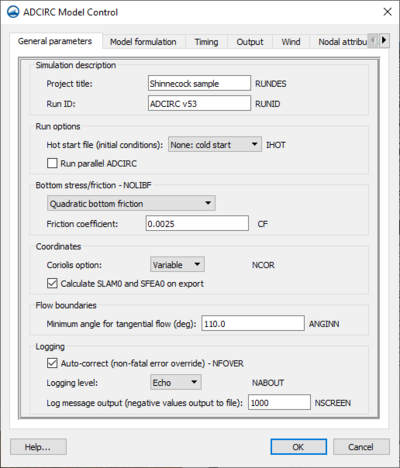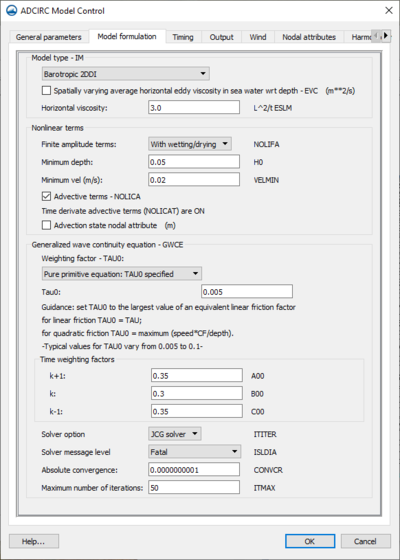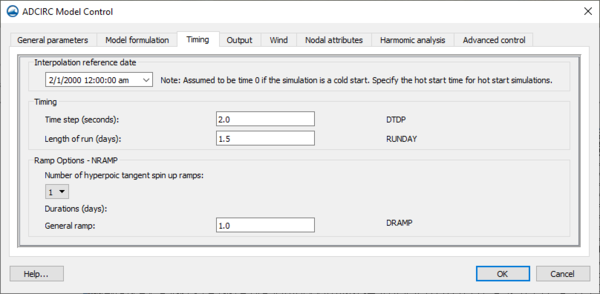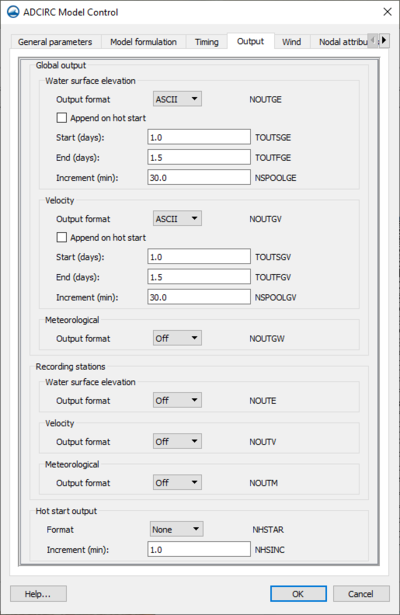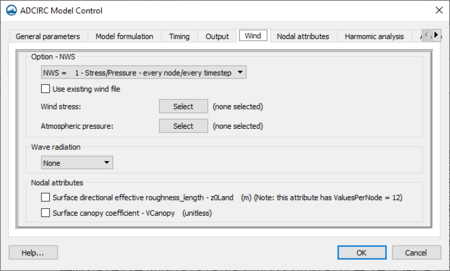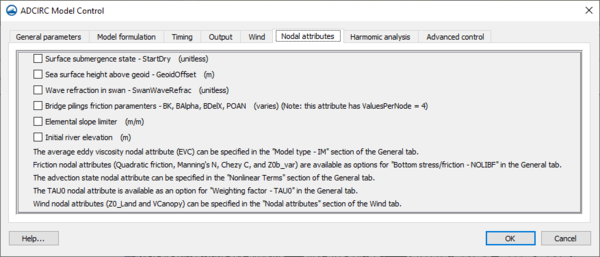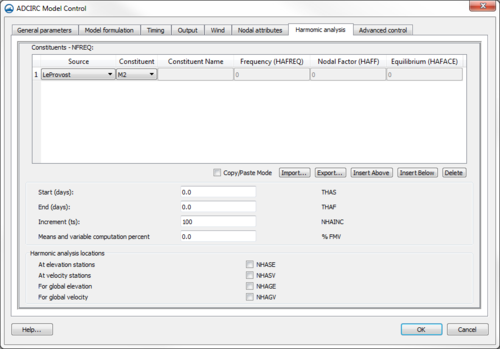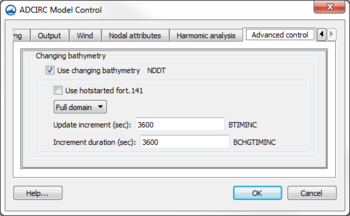User:Jcreer/SMS:ADCIRC Model Control in SMS 13.0: Difference between revisions
| Line 68: | Line 68: | ||
**''Horizontal viscosity'' (ESLM) – Spatially constant horizontal eddy viscosity for the momentum equations (units of length<sup>2</sup>/time). | **''Horizontal viscosity'' (ESLM) – Spatially constant horizontal eddy viscosity for the momentum equations (units of length<sup>2</sup>/time). | ||
*''Nonlinear terms'' | *''Nonlinear terms'' | ||
**Finite amplitude terms (NOLIFA) – Parameter controlling the finite amplitude terms in ADCIRC. | **''Finite amplitude terms'' (NOLIFA) – Parameter controlling the finite amplitude terms in ADCIRC. | ||
***None – Finite amplitude terms are not included in the model run, and wetting and drying of elements is disabled. | ***None – Finite amplitude terms are not included in the model run, and wetting and drying of elements is disabled. | ||
***No wetting/drying – Finite amplitude terms are included in the model run and wetting and drying of elements is disabled. | ***No wetting/drying – Finite amplitude terms are included in the model run and wetting and drying of elements is disabled. | ||
***With wetting/drying – Finite amplitude terms ARE included in the model run and wetting and drying of elements is enabled. | ***With wetting/drying – Finite amplitude terms ARE included in the model run and wetting and drying of elements is enabled. | ||
**Minimum depth (H0) – Minimum water depth. | **''Minimum depth'' (H0) – Minimum water depth. | ||
**Minimum vel – option only appears when "With wetting/drying" is selected | **''Minimum vel'' – option only appears when "With wetting/drying" is selected | ||
**Advective terms (NOLICA) – Parameter controlling the advective terms in ADCIRC. | **''Advective terms'' (NOLICA) – Parameter controlling the advective terms in ADCIRC. | ||
**Time derivative terms (NOLICAT) – Parameter controlling the time derivative portion of the advective terms that occurs in the GWCE form of the continuity equation in ADCIRC. Automatically on when "No wetting/drying" or "With wetting/drying" selected, can be turned on or off otherwise. | **''Time derivative terms'' (NOLICAT) – Parameter controlling the time derivative portion of the advective terms that occurs in the GWCE form of the continuity equation in ADCIRC. Automatically on when "No wetting/drying" or "With wetting/drying" selected, can be turned on or off otherwise. | ||
**Advection state nodal attribute | **''Advection state nodal attribute'' | ||
***If turned on, allows selection of a dataset via a '''Select''' button that brings up a ''Dataset'' dialog. The ''Dataset'' dialog has three buttons: | ***If turned on, allows selection of a dataset via a '''Select''' button that brings up a ''Dataset'' dialog. The ''Dataset'' dialog has three buttons: | ||
****'''Create''' – Brings up the [[SMS:Dataset Toolbox|''Dataset Toolbox'' dialog]] to allow creation of a new dataset. | ****'''Create''' – Brings up the [[SMS:Dataset Toolbox|''Dataset Toolbox'' dialog]] to allow creation of a new dataset. | ||
| Line 82: | Line 82: | ||
****'''Unselect''' – Clears the selection displayed in the ''Name'' field in the ''Dataset'' dialog. | ****'''Unselect''' – Clears the selection displayed in the ''Name'' field in the ''Dataset'' dialog. | ||
*''Generalized wave continuity equation – GWCE'' | *''Generalized wave continuity equation – GWCE'' | ||
**Weighting factor (TAU0) drop-down | **''Weighting factor'' (TAU0) drop-down | ||
***"Pure wave equation: TAU0 = 0" – The GWCE is a pure wave equation. | ***"Pure wave equation: TAU0 = 0" – The GWCE is a pure wave equation. | ||
***"Pure primitive equation: TAU0 specified" – The GWCE behaves like a pure primitive continuity equation. | ***"Pure primitive equation: TAU0 specified" – The GWCE behaves like a pure primitive continuity equation. | ||
Revision as of 20:58, 9 November 2018
The ADCIRC Model Control dialog is where important project parameters are chosen and defined. The six different tabs are listed below.
- General Parameters – Contains such options as model type, cold/hot start, terms, maximum number of iterations, bottom stress/friction, etc.
- Model Formulation
- Timing – Defines simulation run time, start time, and time step options
- Output
- Wind – Enables specific wind types and their options
- Nodal Attributes
- Harmonics Analysis – Defines tidal constituents and harmonic analysis options
- Wind – Enables specific wind types and their options
General Tab
The General parameters tab contains the following:
- Simulation description –
- Project title – Title for the project run. 24 character limit.
- Run ID – ID for the project run. 24 character limit.
- Run options
- Hot start file (initial conditions) – This option allows choosing a file to initialize the values of water level and velocity for a simulation. The files must have been saved from a previous run using the same finite element grid. Default is "None: cold start". Other options are for specific file types containing the initial conditions for the model. Select the desired file type and the Select button will appear. Using the Select button will bring up a browser window to select the hot start file.
- Run parallel ADCIRC
- Bottom stress/friction – NOLIBF – Controls the type of bottom stress parameterization used in a 2D ADCIRC run.
- "Linear bottom friction "
- Friction coefficient – The "Linear" option should only be used for analytical cases when verifying the code. Linear friction causes overdamping in deep water. For "Constant Quadratic" the value of TAU0 should be set based on the principle depth. A value of TAU0 = 0.005 is suggested for deeper water (greater than 10 m depth). For shallow water, TAU0 = 0.02 is recommended. If the domain includes both shallow and deep water, consider the varying quadratic option.
- "Quadratic bottom friction "
- Friction coefficient – The "Linear" option should only be used for analytical cases when verifying the code. Linear friction causes overdamping in deep water. For "Constant Quadratic" the value of TAU0 should be set based on the principle depth. A value of TAU0 = 0.005 is suggested for deeper water (greater than 10 m depth). For shallow water, TAU0 = 0.02 is recommended. If the domain includes both shallow and deep water, consider the varying quadratic option.
- "Hybrid nonlinear bottom friction" – In deep water, the friction coefficient is constant and a quadratic bottom friction law results. In shallow water the friction coefficient increases as the depth decreases.
- Friction coefficient
- Break depth
- Approach factor
- Increase factor
- "Quadratic friction nodal attributes – Fric"
- Select
- "Mannings N nodal attributes – ManningsN"
- Select
- "Chezy C nodal attribute – ChezyFric"
- Select
- "Linear bottom friction "
- Coordinates
- Coriolis option – Constant, Variable. The type of Coriolis forcing used does not impact run time for ADCIRC at all. Variable should be used when the coordinate system is geographic. In this case, ADCIRC will load a Coriolis coefficient for each node based on the latitude of the node. If wanting to run ADCIRC in rectilinear coordinates, specify a constant Coriolis option because the model does not support reprojection from rectilinear to geographic to determine individual latitudes for each node.
- Calculate SLAM0 and SFEA0 on export
- Flow boundaries
- Minimum angle for tangential flow
- Logging
- Auto-correct (non-fatal erro override) – NFOVER
- Logging level
- Log message output (negative values output to file)
____
- Initial Values – Cold Start, Hot Start 1, Hot Start2. This option allows choosing a file to initialize the values of water level and velocity for a simulation. The files must have been saved from a previous run using the same finite element grid.
- Minimum Angle For Tangential Flow
- Terms – Finite Amplitude Terms, Advective Terms, Time Derivative Terms
- Wetting/Drying – Activating this option will cause an Options button to appear. Clicking this button will bring up the Wetting/Drying Parameters dialog.
- Solver Type – Lumped, Direct Banded, Iterative JCG – The Iterative JCG is the default and recommended solver. The other options are in the interface for backward compatibility and analytic tests.
- Absolute Convergence Criteria
- Maximum Number of Iterations per Time Step
- Generalized Properties – Wave Continuity, Lateral Viscosity
Model Formulation Tab
- Model Type – IM
- Drop-down
- "Barotropic 2DDI" – Uses new GWCE and momentum equation formulations.
- "Barotropic 3D" – Uses new GWCE and velocity based momentum equations.
- "Baroclinic 3D" – Uses new GWCE and velocity based momentum equations.
- "Barotropic 2DDI using lumped GWCE (explicit)" – Used to run ADCIRC in lumped + explicit mode, thereby bypassing the iterative solver.
- "Barotropic 3D using lumped GWCE (explicit)" – Used to run ADCIRC in lumped + explicit mode, thereby bypassing the iterative solver.
- Spatially varying average horizontal eddy viscosity in sea water wrt depth (EVC)
- Horizontal viscosity (ESLM) – Spatially constant horizontal eddy viscosity for the momentum equations (units of length2/time).
- Drop-down
- Nonlinear terms
- Finite amplitude terms (NOLIFA) – Parameter controlling the finite amplitude terms in ADCIRC.
- None – Finite amplitude terms are not included in the model run, and wetting and drying of elements is disabled.
- No wetting/drying – Finite amplitude terms are included in the model run and wetting and drying of elements is disabled.
- With wetting/drying – Finite amplitude terms ARE included in the model run and wetting and drying of elements is enabled.
- Minimum depth (H0) – Minimum water depth.
- Minimum vel – option only appears when "With wetting/drying" is selected
- Advective terms (NOLICA) – Parameter controlling the advective terms in ADCIRC.
- Time derivative terms (NOLICAT) – Parameter controlling the time derivative portion of the advective terms that occurs in the GWCE form of the continuity equation in ADCIRC. Automatically on when "No wetting/drying" or "With wetting/drying" selected, can be turned on or off otherwise.
- Advection state nodal attribute
- If turned on, allows selection of a dataset via a Select button that brings up a Dataset dialog. The Dataset dialog has three buttons:
- Create – Brings up the Dataset Toolbox dialog to allow creation of a new dataset.
- Select – Brings up the Select Dataset dialog to allow selection of an existing dataset.
- Unselect – Clears the selection displayed in the Name field in the Dataset dialog.
- If turned on, allows selection of a dataset via a Select button that brings up a Dataset dialog. The Dataset dialog has three buttons:
- Finite amplitude terms (NOLIFA) – Parameter controlling the finite amplitude terms in ADCIRC.
- Generalized wave continuity equation – GWCE
- Weighting factor (TAU0) drop-down
- "Pure wave equation: TAU0 = 0" – The GWCE is a pure wave equation.
- "Pure primitive equation: TAU0 specified" – The GWCE behaves like a pure primitive continuity equation.
- TAU0 – Allows manual entry of the TAU0 factor.
- "Spatially discrete/time constant: TAU0 = -1" – The TAU0 is spatially varying but constant in time.
- "Spatially variable/time constant: TAU0 = -2" – The TAU0 is spatially varying but constant in time.
- "From nodal attribute: TAU0 = -3" – The TAU0 varies spatially and in time,
- If turned on, allows selection of a dataset via a Select button that brings up a Dataset dialog. The Dataset dialog has three buttons:
- Create – Brings up the Dataset Toolbox dialog to allow creation of a new dataset.
- Select – Brings up the Select Dataset dialog to allow selection of an existing dataset.
- Unselect – Clears the selection displayed in the Name field in the Dataset dialog.
- If turned on, allows selection of a dataset via a Select button that brings up a Dataset dialog. The Dataset dialog has three buttons:
- "From local friction: TAU0 = -5" – The TAU0 varies spatially and in time, and is dependent on the local friction.
- Tau0FullDomainMin and Tau0FullDomainMax – Specified values that the spatially and time varying TAU0 scheme must stay between.
- Time weighting factors
- k+1 (A00) – Time weighting factor in the GWCE.
- k (B00) – Time weighting factor in the GWCE.
- k-1 (C00) – Time weighting factor in the GWCE.
- Weighting factor (TAU0) drop-down
- Solver option (ITITER) drop-down – Specifies the solver that will be used for the GWCE.
- "Lumped"
- "JCG solver"
- Solver message level (ISLDIA) drop-down – Determines which messages will be displayed.
- "Fatal" – Fatal error messgs only from ITPACKV 2D.
- "Warnings and minimum" – Warning messgs and minimum output from ITPACKV 2D.
- "Algorithm progress" – Reasonable summary of algorithm progress from ITPACKV 2D.
- "Parameters and info" – Parameter values and informative comments from ITPACKV 2D.
- "Approx solution/iter" – Approximate solution after each iteration from ITPACKV 2D.
- "Original system" – Original system from ITPACKV 2D.
- Absolute convergence (CONVCR) – Absolute convergence criteria (should be no smaller than 500 times the machine precision).
- Maximum number of iterations (ITMAX) – Maximum number of iterations each time step.
Timing Tab
The Timing tab contains the following options:
- Timing
- Time step
- Length of run
- Ramp Options – NRAMP
- Number of hyperpoic tangent spin up ramps
- Duration
- General Ramp
- External flux ramp
- Flux setting time
- Internal flux ramp
- Specified WSE ramp
- Tidal potential ramp
- Wind/Pressure ramp
- Wave stress ramp
- Delay
- Ramp Function Value – This value is a period of time, starting at the beginning of a simulation, that allows the full forcing of the tidal constituents to be gradually applied to the model. This prevents any issues or negative effects from occurring that could harm the results of a simulation.[1]
- Reference time – Specifies that the extracted tidal constituents are earlier or later than the start time of the simulation (see ADCIRC documentation Reftime).
- Start Day – The start time of a project
- Time Step – Time interval between successive measurements
- Run Time – Total length of time a simulation is run
- End Time – Day when simulation should finish
Output Tab
- Global output
- Water surface elevation
- Output format
- Append on hot start
- Start
- End
- Increment
- Velocity
- Ouput Format
- Append on hot start
- Start
- End
- Increment
- Meteorological
- Ouput Format
- Append on hot start
- Start
- End
- Increment
- Water surface elevation
- Recording stations
- Water surface elevation
- Velocity
- Meteorological
- Hot start input
- Format
- Increment
Wind Tab
ADCIRC can model and compute wind velocities and stresses. The ADCIRC model is able to use wind data from a variety of different file types. The SMS interface is not able to read and create all of the available wind data file types. There are three types that SMS is able to read and create. Even though SMS does not read and create these other file types, it does tell ADCIRC that there is data there, where it is, and how to access it for a simulation to run correctly.
One of the parameters found in the fort.22 file (Single File Meteorological Forcing Input File) will tell which of the wind data file types SMS can read and create. The first parameter specified in the fort.22 file is called the Node Wind Stress (NWS) value. This value represents what type of wind data is in the file. It can range from 0 to 100+. SMS can read and create fort.22 files that are of the NWS value of 1, 2, or 5. All other values of the NWS value are only shown and directed to the ADCIRC model by SMS so that a simulation will run correctly.
- NWS = 0 – No Wind
- NWS = 1 – Stress/Pressure – every node/every time step
- NWS = 2 – Stress/Pressure – every node/every time interval
- NWS = 3 – Velocity in US Navy feet Numeric format
- NWS = 4 – Velocity/Pressure in PBL/JAG format
- NWS = 5 – Velocity/Pressure – every node/time interval
- NWS = 6 – Velocity/Pressure on grid
- NWS = 8 – Symmetric cyclone storm from path
- NWS = 10 – 10m Velocity/Pressure NWS AVN files
- NWS = 11 – 10m Velocity/Pressure NWS ETA 29km files
- NWS = 12 – Velocity/Pressure OWI files
- NWS = 15 – HWind files
- NWS = 16 – GFDL files
- NWS = 19 – Asymmetric cyclonic storm from path
- NWS = 20 – GAHM Format cyclonic storm path
Nodal Attributes Tab
- Surface submergence state
- Sea surface height above geoid
- Wave refraction in swan
- Bridge pilings friction parameters
- Elemental slope limiter
- Initial river elevation
Harmonics Analysis Tab
Tidal constituents are variations in tides that are created by different frequencies of astronomical forcing. They arise due to the gravitational influences of the Moon and Sun on the Earth, the tilt of the rotational axis of the Earth, the elliptical shape of the Moon's orbit around the Earth, the shape of the Earth's orbit around the Sun, and other such factors. Many constituents have been defined and are classified based on their cycle lengths. Most of the tidal constituents used in the ADCIRC interface of SMS are either diurnal (one cycle per day) or semidiurnal (two cycles per day) in nature. Harmonic constituents are those variations that have periods of less than half a day. For a table of commonly used constituents see Principal Tidal Constituents.[1]
SMS uses the following databases to provide the tidal constituent data to an ADCIRC simulation:
- LeProvost – The LeProvost database is a set of *.legi files which provide amplitude and phase information. The LeProvost database can be downloaded at: sms.aquaveo.com/leprovost.zip.
- An image of the LeProvost tidal database domain coverage can be found here –
 [2]
[2]
- An image of the LeProvost tidal database domain coverage can be found here –
- ADCIRC – The ADCIRC database includes a grid file and a harmonics file that uses an *.exe extractor to put information into SMS. The ADCIRC database can be downloaded at: sms.aquaveo.com/adcirctides.zip. More information about the ADCIRC database can be obtained at the ADCIRC web page: ADCIRC Tides Databases. The ADCIRC database is only valid for projections in North America.
The path to each database on a computer must be specified in the Preferences dialog by going to Edit | Preferences then selecting the File Locations tab. The two tidal constituent databases (LeProvost and ADCIRC) are only accessible if the SMS project has a global (not local) display projection.
Advanced Controls
- Changing bathymetry
- Use hostrarted fort.141
- Domain
- Update increment
- Increment duration
References
- ^ a b Militello, A., and Zundel, A. K. (1999). “Surface-water modeling system tidal constituents toolbox for ADCIRC,” Coastal Engineering Technical Note CETN IV-21, U.S. Army Engineer Research and Development Center, Vicksburg, MS.
- ^ Le Provost, C., Genco, M. L., and Lyard, F. (1995). “Modeling and predicting tides over the World Ocean,” Quantitative Skill Assessment for Coastal Ocean Models, Coastal and Estuaring Studies, Vol. 47, pp 175-201.
Related Links
- ADCIRC
- Boundary Conditions
- Coverage
- Linear Truncation Error Analysis (LTEA)
- Meshes
- Spatial Attributes
- Steering
SMS – Surface-water Modeling System | ||
|---|---|---|
| Modules: | 1D Grid • Cartesian Grid • Curvilinear Grid • GIS • Map • Mesh • Particle • Quadtree • Raster • Scatter • UGrid |  |
| General Models: | 3D Structure • FVCOM • Generic • PTM | |
| Coastal Models: | ADCIRC • BOUSS-2D • CGWAVE • CMS-Flow • CMS-Wave • GenCade • STWAVE • WAM | |
| Riverine/Estuarine Models: | AdH • HEC-RAS • HYDRO AS-2D • RMA2 • RMA4 • SRH-2D • TUFLOW • TUFLOW FV | |
| Aquaveo • SMS Tutorials • SMS Workflows | ||
